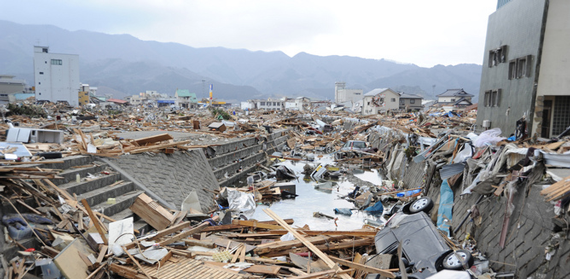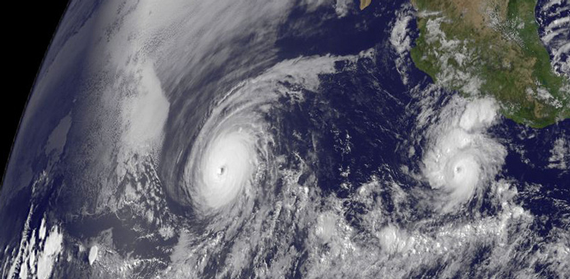Caution: climate change can affect tectonic plates, too. Fox New Insider/flickr, CC BY-SA
Guest post by Matthew Blackett
We are all aware that a number of controversies surround the concept of climate change. But if we put the possible causes to one side, there is a general scientific consensus that the climate is changing. A changing climate might, obviously, have a significant impact on us all but in a world of differing environments and, indeed, of inequalities, some societies seem set to be adversely affected more than others.
As a means of representing those countries which may be more disproportionately affected, a block of 20 of these vulnerable countries has been formed: the “vulnerable20”, or “V20”. In this block, are countries that you might expect, such as the low-lying Pacific island states of Vanuatu and Tuvalu, but others may come as more of a surprise, including Bangladesh, Ethiopia and the Philippines.
This demonstrates that the effects of climate change are both complex and far-reaching, so let’s look at some potential, lesser-known problems we have in store.
With a warming climate, we can expect rising seas as the ice caps in the Arctic and Antarctic regions begin to melt. This stands to affect all low-lying regions of the globe without prejudice: from London, Amsterdam and Miami, to the precariously positioned Pacific Ocean atoll states.
Forgotten victims
But one country that may be overlooked in this context is Bangladesh, the nation ranked number one in the 2015 Climate Change Vulnerability Index (CCVI).
This country of 168m people is located on the fertile but low-lying Ganges-Brahmaputra delta. Annual floods are normal here during the monsoon seasons but, with rising oceans, scientists fear that whole swathes of the country (up to 17%) may be permanently inundated by 2050, forcing the displacement of 18m people and causing the destruction of the country’s prime agricultural regions.
Rising sea levels also will certainly affect many of the world’s low-lying island nations – and those of the Pacific have been particularly vocal in their concerns of the potential impacts. But while we shouldn’t in any way belittle the justifiable concerns of these nations, some recent studiesactually suggest that rather than being engulfed by a rising Pacific, the underlying coral of many reef islands – and the rubble they produce – actually appears to adjust to the prevailing conditions, including the possibility that they may adjust to a rise in sea level.
The coral question
Where problems are more likely, however, are on the more heavily developed reef islands, such as Malé, the capital city of the Indian Ocean state of the Maldives and an island in its own right. There, urbanisation has led to the construction of artificial sea defences, including piers and harbours, which prevent the natural processes of coral growth, rubble accumulation and consequent island adaptation, arguably making this the most vulnerable reef island. Fortunately, urbanised reef islands are the exception and not the rule.
Climate change could lead to more of the most destructive storms NOAA/NASA GOES Project/flickr, CC BY
There have been conflicting findings over recent years, but a number of studies have attempted to demonstrate that with a warming climate, storm patterns and frequencies are changing, too. One hurricane study, for example, shows that while we don’t seem to be experiencing any real increase in the overall number of storms, we are seeing more hurricanes in the the most intense and destructive categories, that is in the four and five categories.
The cause of these observations appears to be higher sea-surface temperatures (anything above 27°C) which aid the development of hurricanes and tropical storms. Countries at risk from these potential superstorms include those which border the Caribbean and those within the tropics, particularly in the Pacific Ocean.
The Philippines is one such vulnerable country, ranked eight in the CCVI, partly as a result of this potential climatic impact but augmented by inequality and a perceived lack of governmental capacity for climate change adaptation.
A double-edged sword
One irony of a warming climate is that it also acts as a double-edged sword in terms of how it affects global precipitation patterns. Over recent decades, for example, rainfall in the drought-prone region of the Sahel in Africa has increased by 10% over the past few decades. This appears to be good news for the region, and models suggest this trend will continue if the climate continues to change. But too much rain may also be a problem, potentially leading to flooding and the associated problems of displaced people and water-borne disease, so we cannot see climate change as a purely good thing for Africa.
In contrast, other parts of the world, such as California, are experiencing severe droughts which are predicted to intensify if global warming continues.
It is also important to remember the possible relationship between climate change and tectonic activity. It is well-established that the construction of dams has, in the past, stimulated earthquake activity, a result of their heavy mass destabilising faults while providing plentiful water for lubrication of the underlying fault systems, allowing them to move more freely.
Climate change earthquakes
The weight and lubricating properties of water have been attributed to earthquakes throughout the globe and even to the recent devastating earthquake in Nepal. Researchers have suggested that the redistribution of weight on the Earth’s surface as ice melts, oceans deepen and rainfall increases, may all add up to an increased seismic risk globally; indeed, seasonal earthquake patterns associated with monsoon rains have been noted.
No one can predict what the full implications of climate change may be, but all the evidence points to a more hazardous world, a world of new interrelations that we cannot hope to understand – perhaps not until it is too late.
Some parts of the world may get off lightly, others may bear the brunt of the impact; the key will be adapting to these changes and, unfortunately, it is likely to be the most vulnerable places that are least able to evolve in time.
Originally written for ‘the Conversation’.





Comments are disabled